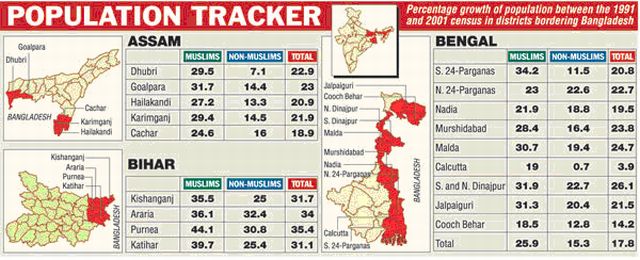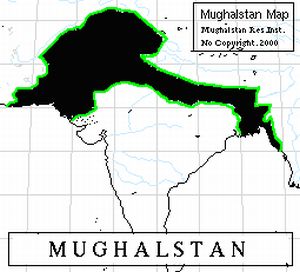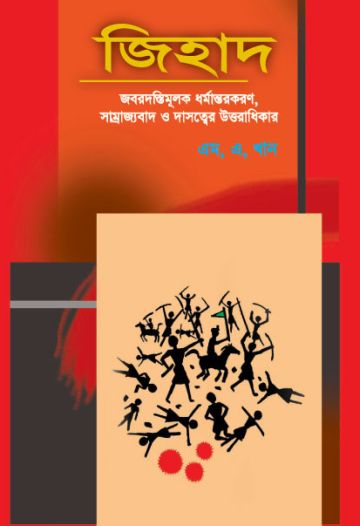Ominous signs for India's state of West Bengal as it is posited to be the first sacrifice on the altar of Mughalistan, a new design to create a contiguous Muslim homeland in South Asia, which is well underway...
Unusual increase of Muslim population in West Bengal
It has been mentioned in my earlier article, Destiny of West Bengal Hindus, that during the partition of Bengal into East Pakistan (now Bangladesh) and West Bengal in 1947, only one district of West Bengal, namely Murshidabad, was dominated by Muslims. But at present, two other districts, Maldah and North Dinajpur, have been added to the list.
Studies have revealed that about 16-17 million Muslim population remain concentrated in the districts of West Bengal bordering Bangladesh, from 24 Parganas to Islampur of North Dinajpur, with Muslims constituting well over 50% of the population. The Kishanganj district (of Bihar), which is contiguous to the West Bengal area, also has a majority of Muslim population.
On 4 September 2007, The Statesman daily published a report, titled “Porous border doubles mangrove population”, which said: “The state government’s failure to stop infiltration through the riverine borders has resulted in a rise in population in the Sundarbans where it is almost double the state’s population growth rate. The resources and the animals living in the state’s delta region are therefore being threatened.”
It added that the population of Sundarbans is growing at over 2% a year, while growth-rate in the state is 1.2%.
And with such a high growth rate, the Sundarbans will have 4.4 million people by 2012. The state forest department has already sounded an alarm saying that high rate population growth caused rampant deforestation and a huge loss of forest resources. But the most serious danger it poses is that, with such a high rate of infiltration by Bangladeshi Muslims in the region would turn the districts of North and South 24 Parganas into Muslim-dominated much earlier than predicted before. Meanwhile, it will turn five districts of the state, bordering Bangladesh, into Muslim-majority ones.
Other studies on the border-belt of West Bengal yield some telling statistics: In West Bengal, the concentration of the infiltrators is quite high in the border districts like North and South Dinajpur, Cooch Behar, Nadia, Murshidabad, Malda and North and South 24 Parganas. About 20-40% villages in these border districts are said to be Muslim-dominant. There are indications that the concentration of the Muslim community, including Bangladesh immigrants, in the villages has resulted in the majority Hindu community moving to urban centres. Though several towns in the border districts are now Hindu-majority, but are surrounded by villages mostly dominated by Muslims.
According to the 2001 census, as already mentioned, the Muslim population has increased to over 28% of the total in West Bengal. In state of Assam, Muslims constitute at least 31% of the total population.
A closer look at the map of West Bengal (see Fig. 1) reveals that the whole area—from North 24 Parganas District, proceeding through Nadia, Murshidabad, Malda and North Dinajpur, before entering the narrow neck of land lying through Raiganj and Dalkola of Islampur subdivision before passing through the Kishanganj district of East Bihar to enter Siliguri—is being turned into a Muslim-majority one. Furthermore, in the north Bengal districts of Darjeeling, Jalpaiguri and Cooch Behar and the districts of Dhubri, Goalpara, Bongaigaon, Kokrajhar and Barpeta, are fast turning Muslim-dominated (see Fig. 2).
This demographic change, ominous as it may, is due to influx of illegal Bangladeshi immigrants to these bordering districts. It need not be emphasized that another Muslim country, predominantly Bengali-speaking, is in the making in eastern India.
Figure 1: The region of West Bengal fast turning into Muslim Majority area

“All this has been revealed by a recent report of the union home ministry on infiltration from India's neighbour. The report has been prepared on the basis of facts and figures provided by the Task Force on Border Management and Assam's former governor S.K. Sinha. Three districts, viz. Malda, Murshidabad & North Dinajpur and 63 (sixty three) blocks in West Bengal.
“Again, an analysis upon the projection into the 2001 Census hints at abnormal Muslim growth everywhere in West Bengal, where the Muslim population is 28% of the total state population”, says an analyst.
Similarly, the fate of 40 Assembly seats in Assam depends on the votes cast by illegal Bangladeshi Muslim infiltrators.
“There have been reports that more Madarsas and mosques are sprouting along the borders, which in itself is an indication of increased Muslim population in the area," disclosed an intelligence official.
The Intelligence Bureau and the Home Ministry conducted their last study in 1992, and the report was kept secret, because of sensitive nature of the findings. It was ultimately leaked and the estimated number of illegal migrants from Bangladesh was anywhere between 1.5 crore and 2 crore (15 to 20 million).
It is time for a fresh study to determine the exact figure for illegal Bangladeshi Muslim infiltrators in West Bengal. There have been new intelligence reports that militants are using madarsas and mosques as safe-havens, and for storing arms and ammunition. According to reports, a large number of madarsas and mosques have mushroomed in bordering areas with Nepal, lower Assam and Bengal. This agrees another secret survey that has revealed that nearly 40% villages in the border districts of Bengal are predominantly Muslim. There are reports that concentration of the Muslim community, including the Bangladeshi immigrants in the villages, has resulted in the majority Hindus moving to urban areas.
Along with madarsas and mosques, a large number of Muslim NGOs have sprung up in the area bordering Nepal. “Most of these madarsas are used for Jihadi activities, targeted at India, by Pakistan-backed terrorists. The NGOs, working for the social and educational uplift of the Muslim community, receive substantial and completely unregulated funding from Saudi Arabia, Kuwait, Libya and other Islamic countries, says an intelligence report.
Figure 2: The districts of West Bengal, Assam and Bihar, bordering Bangladesh, being turning into Muslim-dominant.

As a result of these developments, the Bangladeshi Muslims are now virtually controlling the affairs of the West Bengal state Assembly, and dictating terms to the state government of West Bengal in all respects as Muslim electorates have a clear majority in as many as 53 out of 294 Assembly constituencies in the state. Consequently, the plight of majority Hindu electorates worsened in the State.
There are at least 5 powerful Muslim ministers in the West Bengal state cabinet, namely Abdur Rezzak Mollah (Minister of Land & Land Reforms), Anisur Rahaman (Minister of Animal Resources Development), Mortaja Hossain (Minister of Agriculture, Marketing & Relief), Anarul Haque (Minister of State for Public Health, Engineering) and Abdus Sattar (Minister of State for Minority Development & Madrasa Education), looking after the interest of the Muslims in the state.
The unusual increase of Muslim population in West Bengal—in other words, the Islamization of West Bengal—is not an isolated event, but it is only a part of a bigger game for the creation of an independent Islamic state, called Mughalstan.
The New Islamic State of Mughalstan
Mughalistan (or Mughalstan) will be an independent Muslim homeland in the subcontinent, proposed by the Muslims of India, which will include all of North and Eastern India, to be merging with Pakistan and Bangladesh, through a large corridor of land running across the Indo-Gangetic plain, the heartland of India. This will be a partitioned of Indian for a second time. See these reports for more: http://factindiablog.wordpress.com/2009/01/04/moghulistan/; http://en.wordpress.com/tag/mughalstan-research-institute/
It’s worth noting here that all these conspiratorial developments to partition India for the second time are the result of our unwise leaders, particularly Gandhi, of the Indian National Congress and their policy of Muslim appeasement. The reader should recall that, in 1940, Indian Union Muslim League (IUML) proposed the creation of Pakistan, a separate homeland for Muslims by dividing India. The proposal also entailed that the creation of Pakistan would follow an exchange of population: all Muslims would move to Pakistan, while non-Muslims would move to the Indian Union. But after Pakistan was created, the exchange of population could not take place due to strong opposition by Gandhi. Many nationalist leaders, including Dr B R Ambedkar, pressed the Indian government to carry out the said population exchange. But Prime Minister Nehru, yielding to Gandhi’s will, dropped the idea.
Figure 3: The New Islamic state of Mughalstan
 Lord Mountbatten, the then Governor General of India, repeatedly requested Nehru to finish the task of population exchange, but all such requests fell on deaf ears. After the communal riots in Bihar, as a retaliation of the massacre of Hindus in Calcutta and Noakhali, Jinnah had requested Nehru to hasten the process of population exchange but with no result. Dr Ambedkar strongly criticized the policy of the government and warned that if a single Muslim stays back in India, he will create problem in the future. So, it is needless to say that all these precarious developments in India, mentioned above, are simply fallout of the nonperformance of the logical step of population exchange.
Lord Mountbatten, the then Governor General of India, repeatedly requested Nehru to finish the task of population exchange, but all such requests fell on deaf ears. After the communal riots in Bihar, as a retaliation of the massacre of Hindus in Calcutta and Noakhali, Jinnah had requested Nehru to hasten the process of population exchange but with no result. Dr Ambedkar strongly criticized the policy of the government and warned that if a single Muslim stays back in India, he will create problem in the future. So, it is needless to say that all these precarious developments in India, mentioned above, are simply fallout of the nonperformance of the logical step of population exchange.
It should be mentioned here that the elaborate plan for a second partition of India for the creation of Mughalstan is the brainchild of the Mughalstan Research Institute (MRI) of Jahangir Nagar University in Bangladesh, under the patronage of the two intelligence agencies, Pakistan’s Inter Services Intelligence (ISI) and Bangladesh’s Director General of Forces Intelligence (DGFI).
Fig. 3 shows the map of Mughalistan released by the Mughalstan Reaserch Institute of Bangladesh.
The map shows that the land, called Mughalstan, would serve the purpose of a corridor between Pakistan and Bangladesh via India. Furthermore, once the creation Mughalstan is completed, Muslims would have a continuous chain of Muslim- dominated countries (dar-ul-Islams) from East Africa to Indonesia.
It should also be mentioned here that Osama Bin Laden has thrown his support behind the concept of creating Mughalstan as a part of Greater Pakistan to “liberate” the Muslims of India from the Hindus. The Mumbai underworld gang (led by Karachi-based don Dawood Ibrahim who executed the gruesome 1993 Mumbai bombings), Jamaat-e-Islami, Lashkar-e-Tayyaba, Jaish-e-Mohammad and Hizbul Mujahideen have declared their unified support for creating an undivided Islamic nation in the Indian subcontinent. The Students Islamic Movement of India (SIMI) and Indian Mujahideen are working in tandem with the aforementioned organizations to wage Jihad against the Hindus of India.
It is well known that SIMI is working for the liberation of India in the cause of Islam. It aims to reconquer India for Islam and establish the supremacy of Islam through the reestablishment of the Khilafat (Islamic Caliphate), by waging Jihad against the Indian government, thereby, destroying the present democratic and secular set-up by the imposition of Shariah Law.
The Indian Mujahideen have sent several emails claiming responsibility for several bombings in Lucknow, Varanasi and Faizabad (in Uttar Pradesh), Bangalore, Jaipur, Ahmedabad and New Delhi in 2007 and 2008. The emails refer to notorious Islamic conquerors of India like Mohammed bin Qasim, Mohammad Ghauri and Mahmud Ghaznawi etc. as their role-models, refer to Hindu blood as “blood to be the cheapest of all mankind” and taunt Hindus that their “[Hindu] history is full of subjugation, humiliation, and insult [at the hands of Islamic conquerors]”.
Figure 4: Map of Mughalstan recovered from the HQ of SIMI by the investigating officers

The Indian Mujahideen send emails warning Hindus that “Either accept Islam and save yourselves, or be prepared to face a horrible fate.” Some emails read: “O Hindus! O disbelieving faithless Indian kafirs! Haven’t you still realized that the falsehood of your 33 crore dirty mud idols and the blasphemy of your deaf, dumb, mute and naked idols of Ram, Krishna and Hanuman are not at all going to save your necks, Insha-Allah, from being slaughtered by our [Muslim] hands?”
Northern India: Uttar Pradesh and Bihar
An analysis of change of demographic pattern along the northern belt of Uttar Pradesh and Bihar, bordering Nepal, reveals that the process of creation of the said Mughalstan is silently under way. In the backward Mewat region of Haryana (and Rajasthan), Muslims form 66% of the population.
In 2005, the Congress (I) state government in Haryana, according to its policy of Muslim appeasement, quietly created a Muslim-majority district called Mewat, by vivisecting the district of Gurgaon. This move has encouraged the local Islamic groups, considerably. After all, it was in Haryana’s Mewat region in 1992, that Muslim mobs in Nuh town had hacked Hindus, destroyed Hindu temples and brazenly slaughtered cows openly on streets after seizing them from Gau Shalas (cow shelters). One may add the incidents of bombing, in 2008, targeting Hindu temples and civilians in Jaipur, Rajasthan, to strike terror among the Hindus in Rajasthan.
Today, the mass conversion of Hindu villagers to Islam, purchasing tens of thousands of Hindu girls for use as sex-slaves, cow-slaughter and social boycott of Hindus is common in Muslim families in Mewat. The average Muslim birthrate of 12-15 children per household in Mewat is increasing even more by cases like the Mohammed Ishaq family where the patriarch has produced 23 kids from his only wife, Bismillah.
According to this report, “Muslim-majority cities like Old Delhi and Malerkotla (in Indian Punjab) provide not only shelter to Jihadi terrorists, but also geographic continuity to Muslim-dominated districts of western Uttar Pradesh (UP), especially Agra, Aligarh, Azamgarh, Meerut, Bijnor as well as Muzaffarnagar, Kanpur, Varanasi, Bareilly, Saharanpur and Moradabad. Muslim attacks on Hindu religious processions, religious riots and bomb blasts occur frequently in UP, as was seen in Mau, Ayodhya, Lucknow and Kanpur. The UP state population of Muslims has risen to 18% today.”
Fig. 5: The demographic pattern in the Mewat region of Haryana, areas of Uttar Pradesh and Bihar bordering Nepal and areas of West Bengal and Assam, bordering Bangladesh, show that the creation of Mughalstan is silently in progress.

The next door is Bihar where Muslim population is 17% of the total, but religious tensions are simmering. Along the Indo-Nepal border of Uttar Pradesh and Bihar, around 1,900 Islamic madrassas have sprung up on both sides of the border in recent times. “There has been an exponential increase of Madrassas on both sides of Indo-Nepal border in the recent past of which around 1100 are in India while the rest are in Nepal,” says Tilak Kak, the Director General of Sashastra Seema Bal (SSB).
These large number of Madrassas are disproportionate to the Muslim population in the area. India’s Task Force on Border Management, in its report of October 2000, wrote about the ominous developments along the India-Nepal border: “On the Indo-Nepal border, Madrassas and mosques have sprung up on both sides in the Terai region, accompanied by four-fold increase in the population of the minority community in the region. There are 343 mosques, 300 Madrassas and 17 mosques-cum- Madrassas within 10 kilometres of the border on the Indian side. On the Nepal side, there are 282 mosques, 181 Madrassas and eight mosques-cum- Madrassas”. Reader need not be reminded that madrassas are factories for production antinational jihadis.
The report also says, “These mosques and madrassas receive huge funds from Saudi Arabia, Iran, Kuwait, Pakistan and Bangladesh. Managers of various Madrassas and Ulema maintain close links with the embassy officials of those countries located at Kathmandu. Financial assistance is also channeled through the Islamic Development Bank (Jeddah), Habib Bank of Pakistan and also through some Indian Muslims living in Gulf countries.
Pakistan’s Habib Bank, after becoming a partner in Nepal’s Himalayan Bank, has expanded its network in the border areas including Biratnagar and Krishna Nagar. It is suspected that foreign currency is converted into Indian currency in Nepal and then brought to India clandestinely.
Madrasas and mosques on the Indo-Nepal border are frequently visited by prominent Muslim leaders, Tablighi Jamaats (proselytizing groups) and pro-Pak Nepali leaders. Officials of Pak Embassy have come to notice visiting Terai area of Nepal to strengthen Islamic institutions and to disburse funds to them. Pro-Pak elements in Nepal also help in demographic subversion of the Terai belt.”
The facts and figures presented above, indeed, tell of a gloomy future not only for West Bengal, but also for entire India. Mr. R. K. Ohri, former Inspector General of Police, Arunachal Pradesh, cautioned that an Islamic Caliphate is rising on India’s flanks, from Bangladesh to West Asia, and that the shadow of the Mughalistan corridor is now visibly manifesting in various districts along the Indo-Nepal and Indo-Bangladesh border. The demand for a ‘Muslim Bangaboomi’ has already been raised, warns ex-MP B. L. Sharma (Prem). While traveling in West Bengal to investigate certain atrocities against Hindus a few years ago, his convoy came under attack by Bangladeshis settlers.
When demographer J. K. Bajaj and his colleagues prepared a mathematical model of the demographic challenge facing India, they found it exactly matched the map prepared by Bangladesh’s Mughalstan Research Institute. Experts assume that the map has been prepared by the I.S.I., because the ‘Mughalstan’ spelling indicates a Punjabi mind, because the pure Urdu spelling should be ‘Mughalistan’ (Mughal-i-stan).
Notably, a severe danger is knocking at the door of West Bengal as it would be the first sacrifice at the altar of Mughalstan.



Comments powered by CComment